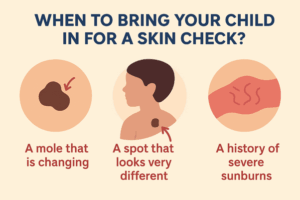
When it comes to skin cancer, most people think of adults who have spent years in the sun. But did you know that children and teens are also at risk? While skin cancer is more common in adults, early skin checks can help detect any issues early, set up lifelong habits of sun protection and monitor the skin for any changes that might be concerning down the line. So, should children get skin checks? Let’s explore the importance of early skin health and why it’s something every parent should consider.
Why Are Skin Checks Important for Children?
Skin cancer in children is rare, but it’s still something to be aware of. The goal of regular skin checks for children isn’t to detect cancer early (though that’s an important part of it) but to build good habits around sun protection and to identify any unusual skin conditions that might require further attention.
Here’s why skin checks for kids are important:
- Skin Damage Starts Early: Studies show that most of a person’s lifetime sun exposure occurs before the age of 18. Sunburns in childhood can increase the risk of developing skin cancer later in life, especially melanoma, the deadliest form of skin cancer. Therefore, monitoring your child’s skin health from a young age can help identify issues before they become serious.
- Identifying Unusual Skin Conditions: Children can develop benign skin conditions like moles, birthmarks or rashes that might need attention. Regular skin checks help differentiate between harmless conditions and those that need medical intervention, such as suspicious moles that could potentially turn into skin cancer.
- Early Awareness: Starting skin checks at a young age teaches kids to be mindful of their skin health. When children are taught to check their skin early on, they’ll be more likely to do it as they grow older, creating a culture of preventative care.
How common is skin cancer in children?
- Skin cancers (especially basal cell and squamous cell types) are overwhelmingly adult diseases and increase with age.
- Paediatric melanoma is rare, but it does occur — often with presentations different from adult cases.
- Most moles and freckles in children are benign; many new nevi appear during growth and adolescence.
- When Your Child Has a Family History of Skin Cancer
If there’s a family history of skin cancer, particularly melanoma, it’s important to be extra cautious. Children with a parent or sibling who has had skin cancer may have an increased risk themselves. In this case, early skin checks can help catch any abnormalities early on. A health care professional may recommend starting skin checks as early as 3 to 5 years old.
- If Your Child Has Fair Skin, Light Eyes, or Freckles
Children with fair skin, light-coloured eyes, and those who easily burn or freckle are at higher risk of skin cancer later in life. If your child falls into these categories, it’s important to start performing regular self-exams and schedule a professional check-up with a health care professional. Even without a family history of skin cancer, these kids need extra vigilance.
- If Your Child Has Many Moles or Unusual Birthmarks
Kids who have an unusually large number of moles (more than 50), or those with atypical birthmarks (irregularly shaped, multi-coloured, or larger than normal), may have an increased risk of developing melanoma. In this case, it’s a good idea to start having professional skin checks early on.
- If Your Child Spends a Lot of Time Outdoors
Children who are frequently outside, especially in sunny climates or at higher altitudes, are at greater risk of sun damage. Even with the best intentions, kids often forget to reapply sunscreen, wear hats or seek shade. If your child is an outdoor enthusiast, you should pay extra attention to their skin health and consider annual skin checks starting around the age of 5 to 6.
What Happens During a Skin Check for Children?
A skin check for children is similar to one for adults, but it’s often quicker and less formal. Here’s what to expect:
- Full-Body Examination: A paediatric health care professional will look at your child’s skin from head to toe. They will check for moles, birthmarks, rashes, or other skin conditions. They’ll also note any changes to existing moles.
- Focus on Suspect Moles: The health care professional will examine any moles that appear irregular, with asymmetry, uneven edges, multiple colours, or abnormal size. They’ll also pay attention to any moles that have recently changed or started bleeding.
- Education: The health care professional will talk to you and your child about sun protection, skin health, and how to do self-exams. They may recommend you start checking your child’s skin at home, especially after time spent outdoors.
- Follow-Up: If any concerns arise, such as a suspicious mole, the health care professional may recommend a follow-up appointment or a biopsy to rule out skin cancer. In most cases, children will be given a clean bill of health.
How to Do Skin Checks at Home for Your Kids
As a parent, you play a critical role in keeping track of your child’s skin health. Here’s how you can do skin checks at home:
- Check After Baths or Showers: Bath time is a great time to examine your child’s skin since it’s clean and dry. Gently look for any unusual spots or moles. You can do this while they’re playing or right after they’re out of the bath.
- Monitor Changes in Moles: If your child has moles or freckles, keep an eye on them for any changes in shape, colour or size. If something looks unusual, consult your paediatrician or health care professional.
- Use the ABCDE Rule for Moles:
- Asymmetry: One half doesn’t match the other.
- Border: Irregular edges.
- Colour: Multiple colours or uneven distribution of colour.
- Diameter: Larger than 6mm, about the size of a pencil eraser.
- Evolution: Any changes over time.
- Teach Your Child: As your child grows older, teach them to recognise changes in their skin, and encourage them to bring up any concerns they have about their skin. This establishes a lifelong habit of self-care and awareness.
Skin Cancer Prevention: Start Early with Sun Protection
While skin cancer checks are important, the best strategy is prevention. The earlier children develop good habits, the better they’ll be at protecting their skin in the future. Here are some tips:
- Apply sunscreen every two hours, and more frequently if your child is swimming or sweating.
- Seek shade during peak sunlight hours (10 a.m. to 4 p.m.).
- Wear protective clothing, including hats, sunglasses, and UPF-rated clothing.
- Avoid tanning beds at all costs—children should never use them.
- Reapply sunscreen after swimming or sweating, even if the label says “waterproof.”
Conclusion: Should Children Get Skin Checks?
Yes, children should start having skin checks if they have a family history of skin cancer, fair skin, or any other risk factors. While it’s rare for children to develop skin cancer, the earlier you start taking care of their skin, the better their chances for long-term skin health.
Regular skin checks—whether performed by a paediatric health care professional or by you at home—help ensure that any concerns are addressed early, potentially saving your child’s life down the road. And most importantly, teaching your child about proper sun care and the importance of protecting their skin will help them form habits that will last a lifetime.
Have you scheduled a skin check for your child? How do you ensure their skin stays healthy and protected from the sun?

